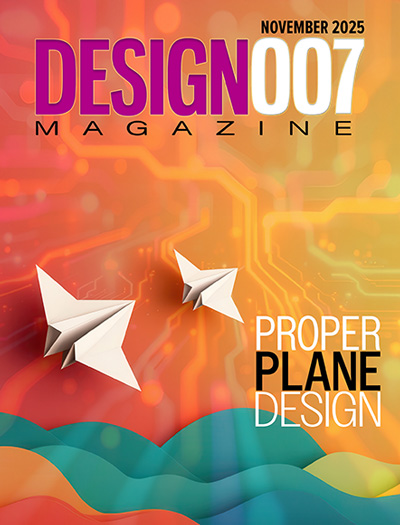-

- News
- Books
Featured Books
- design007 Magazine
Latest Issues
Current Issue
Designing Proper Work-Life Balance
In this issue, we hear from designers, marketers, and business owners on how they apply their professional skills to their personal lives to build a healthier work-life balance.

Designing Proper Planes
Without planes, designers would have to create thousands of traces to accomplish the same objectives. Power planes provide low impedance and stable power, and ground planes stabilize reference voltage, improve thermal performance, and help preclude EMI issues.

Power Integrity
Current power demands are increasing, especially with AI, 5G, and EV chips. This month, our experts share “watt’s up” with power integrity, from planning and layout through measurement and manufacturing.
- Articles
- Columns
- Links
- Media kit
||| MENU - design007 Magazine
Electronic Design Automation Market to Reach $28.27 Billion by 2027
June 18, 2019 | PRNewswireEstimated reading time: 1 minute
Electronic design automation market is expected to grow $10.31 billion in 2018 and is expected to grow at a CAGR of 12.0% during the forecast period 2019−2027, to account for $28.27 billion by 2027.
Electronic design automation software comprises of multiple tools and applications. Integrating these tools according to the customers' demand sometimes becomes a complicated job. The complex requirements of the end-users regarding highly stable and accurate product positioning is addressed with the help of EDA. Rising complexities and cost challenges faced by the industries for implementation of expensive complex designs is key influencer driving the electronic design automation market.
Key trend which will predominantly effect the electronic design automation market in coming years is demand for machine learning in EDA software to gain significant momentum in the electronic design automation market. The EDA software over the years have evolved in response to progressively aspiring goals for high performance, low power and decreased design cycle time. This evolution in the EDA software is also expected to meet the unfulfilled need for methods, models and tools that would allow faster and more accurate design and verification of microelectronic systems and circuits. A behavioral approach, lately, has been discovered to be able to achieve these goals. Therefore, the machine learning to the EDA tools business is having a substantial impact. The technology is anticipated to cut the cost of designs by enabling the tools to provide solutions to usual issues, which might take longer for the design teams to resolve manually. This not only reduces the cost but also paves the path for novel designs and more semiconductor chips from more businesses.
Electronic design automation market by application is segmented into aerospace & defense, consumer electronics, telecom, automotive, industrial, others. Critical success factors such as accuracy, efficiency and productivity are propelling the need for advanced automation tools in designing, engineering and manufacturing.
Additionally, the appropriate software enable companies address cost-related and time-to-market challenges thoroughly, via process optimization. Thus, various industries including, consumer electronics, telecom, aerospace & defense, and industrial among others are implementing electronic design automation depending on the requirements. The continuous advancements in the consumer electronics and automotive industries would further raise the demand for electronic design automation market over the forecast period.
Testimonial
"In a year when every marketing dollar mattered, I chose to keep I-Connect007 in our 2025 plan. Their commitment to high-quality, insightful content aligns with Koh Young’s values and helps readers navigate a changing industry. "
Brent Fischthal - Koh YoungSuggested Items
Kitron Receives EUR 19 Million Guidance, Control and Targeting Systems Order
12/11/2025 | KitronKitron has received an order with an estimated value of EUR 19 million for the production and supply of advanced electronic components used within guidance, control and targeting systems.
Pan-European Electronics Design Conference Returns Better Than Ever
12/11/2025 | I-Connect007 Editorial TeamFollowing a highly successful inaugural event, the Pan-European Electronics Design Conference (PEDC) returns, this time to Prague, Czech Republic, Jan. 21–22, 2026. In this Q&A, Peter Tranitz, the Global Electronics Association’s senior director of technology solutions, shares the value of attending PEDC, which aims to bring together PCB designers from across Europe to learn, network, and share their own knowledge.
I-Connect007 Announces the December Issue of Advanced Electronics Packaging Digest
12/10/2025 | I-Connect007Landing in inboxes Monday, Dec. 15, the next issue of Advanced Electronics Packaging Digest (AEPD) explores some of the most pressing questions shaping U.S. advanced electronics capability, from defense readiness to power constraints and the fast-moving world of printed electronics. This month, we spotlight the technologies, strategies, and industry perspectives driving next-generation manufacturing forward.
ASMPT Presents Optimized Odd Shaped Component (OSC) Package
12/10/2025 | ASMPTWith the optimized SIPLACE OSC Package, technology and market leader ASMPT SMT Solutions is strengthening the competitiveness of modern electronics manufacturing.
SMTA Pan Pacific Strategic Electronics Symposium Program Finalized
12/09/2025 | SMTASMTA announced that the program is finalized for the 30th Annual Pan Pacific Strategic Electronics Symposium.


